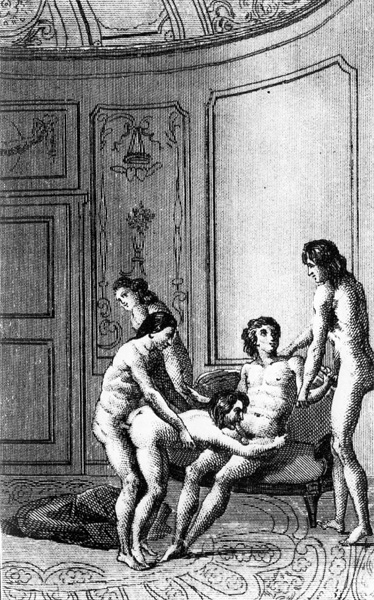November 13, 2004
de Sade: Juliette
Another image taken from online archive of the 1789 Dutch edition of "The story of Juliette" and the 1797 edition of "The story of Justine" by the Marquis de Sade:

The image does look as if these texts describe a harmless aristocratic sexual romp. However, de Sade and his publisher were both arrested by the Minister of Police in 1801 for writing and publishing Justine and Juliette.
De Sade was not allowed a trial, and he was put put directly in prison. His detractors had him declared insane, and he was transferred to Charenton Asylum, where continued efforts were made to silence his pencils and subsequent influences on the outside world. Pre-revolutionary France took exception to the Marquis de Sade's tale sof strange desires, perverse pleasures, and the ultimate corruption of innocence.
The narrative background to the above literary texts is that Justine and Juliette are orphans who forced to leave the orphanage where they have been brought up. Juliette quickly takes refuge in a brothel and embarks on a prosperous career of vice and murder. Justine attempts to follow a more virtuous path but becomes a victim of the perverse and decadent world of pre-revolutionary France.
According to this a account Justine is the story of a chaste, virtuous woman who is shown in the most graphic and vile ways that such virtue is rewarded only with suffering in the world outside convent walls. The virtuous Justine, who keeps to the moral rules, is rewarded with rape and humiliation
Juliette is the story of the virtuous Justine's sister, who embraces the libertine philosophy that her sister shys away from. Upon leaving the convent, Juliette makes the acquaintances of a few people who proceed to show her the ways of the wicked world, peppered with lengthy discussions in opposition of virtue, chastity, and all things religious.
On this account over at Lust Magazine de Sade's philosophy is about unleashing the beast that lies within all human beings, as is his belief that goodness and virtue can only lead to ill consequences and is punished with vice.
In the Dialectic of Enlightenment Adorno and Horkheimer give a more complex account. They say, with Immanual Kant in mind, that:
" The moral teachings of the Enlightenment bear witness to a hopeless attempt to replace enfeebled religon with some reason for persistng in society when interest is absent." (p.85)
Further on in the text Adorno and Horkheimer discuss the way the way Juliette operates. Their picture of Juliette is that she is a child of the Enlightenment. They say that:
"...the work of the Marquis de Sade, like that of Nietzsche, constitutes the intransigent critique of practical reason, in contradistinction to which Kant's critique itself seems a revocation of his own thought. It makes the scientistic the destructive principle. Justine, the virtuous sister, is a martyr for the moral law. Juliette draws the conclusion that the bourgeosie wanted to ignore: she demonizes Catholicism as the most-up-to-date mythology, and with it civilization as a whole...In all of this Juliette is by no means fanatical....her procedures is enlightened and efficient as she goes about her work of sacrilege....Julitte embodies...the pleasures of attacking civilization with its own weapons. She favours system and consequence.She is a proficient manipulator of the organ of rational thought." (p.94)
As they point out Juliette believes in science and despises any form of worship whose rationality cannot be demonstrated. She is a child of the aggressive Enlightenment.
How does that account fit in with your account?
sade and enlighment
Posted by: nasih on December 14, 2004 02:20 AM